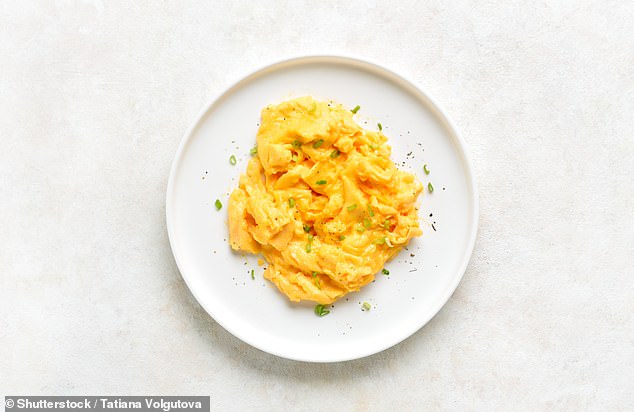Scrambled eggs are one of the simplest dishes a home cook can learn to make.
And yet, there’s often a vast difference in the quality of scrambled eggs cooked at home compared to those served up at a café or restaurant.
A post in a foodie forum on this very subject ignited passionate online discussion after a man asked ‘Why are scrambled eggs at restaurants always so good?’.
He detailed how ‘amazing’ scrambled eggs taste when he ordered them at a café or restaurant, but lamented being unable to ‘replicate them at home’.
He praised the brunch favourite for having a moist texture and soft, mild flavour, which was in stark contrast to his homemade version, which he said usually ‘tends to be dry and have a stronger flavour’.
The home cook also noted that scrambled eggs at a café ‘stick’ perfectly to the toast, while at home the eggs ‘just fall off’ the bread.
The community quickly chimed in to help, with the post attracting almost 1000 responses.
Initially, the presumed answer was that restaurants cook their scrambled eggs with ‘an ungodly amount of butter’, or added lashings of salt, milk or cream.

A post in a foodie forum on this very subject ignited passionate online discussion after a man shared asked ‘Why are scrambled eggs at restaurants always so good?’

He detailed how ‘amazing’ scrambled eggs taste when he ordered them at a café or restaurant, but lamented being unable to ‘replicate them at home’
But surprisingly, many professional cooks disagreed.
They explained that in the specific instance of scrambled eggs, the difference between homemade and professional quality often boiled down to technique – rather than fancy additional ingredients.
One detailed reply from a professional chef read: ‘[D]efinitely no milk or cream in the eggs. Just eggs scrambled up until they’re homogeneous.’
The chef offered a detailed step-by-step explanation for achieving this perfect scrambled egg consistency – starting by beating the eggs well in a bowl with a whisk.
‘Once my egg pan is hot (water sizzles away but doesn’t dance), I put in a couple of nice knobs of butter, like at least a tablespoon or so, and let the butter melt and coat the pan.
‘Once the butter has stopped foaming, I add the eggs and season with a decent pinch of kosher salt… and a few turns of fresh cracked black pepper and start cooking them.’
Using a ‘silicone spatula’ to move the eggs around the pan, the professional cook explained that the next moments were critical.
‘I cook them until they’re slightly runny still and then pull the pan from the heat and keep moving them around to let the heat from the pan finish them,’ he advised.

A professional chef recommended that scrambled eggs should be cooked on the stove only ‘until they’re homogeneous’ – before removing the pan from the heat. This is because the eggs will continue cooking in the hot pan
Others echoed the chef’s advice around this specific cooking method.
‘Scrambled eggs should be pulled [off the heat] whilst they are still runny, as they don’t stop cooking immediately when you pull them from the heat. The eggs will continue to cook via carry over heat,’ one said.
A helpful suggestion also advised making ‘sure you move fast with that spatula so that nothing is touching the surface for too long.’
Another useful tip was to look for the eggs to appear ‘shiny when you take them off the pan’.
‘Remember they’re still cooking after the heat goes off,’ they said.
There was also a general consensus that cooking in butter and adding salt were requisite to achieving professional-quality scrambled eggs.
Others noted that the addition of rich dairy ingredients like pouring cream or crème fraiche would indeed enhance the final flavour of scrambled eggs – but that they were not an absolute necessity.
The scrambled eggs discussion echoed a similar conversation that took place recently about how to recreate professionally made mashed potatoes.
Again, many initially presumed that large amounts of salt and butter were the answer. However, many chefs piped up to explain in there is far more to the art of a velvety mash.

It’s an age old question: why is mashed potato always so much better when the experts make it? A recent post saw professional chefs reveal the technique and cooking gadgets they use to achieve elevated mashed potatoes
The thread called on professionals to reveal their secrets, with chefs spilling their once gate-kept methods – and the gadgets they swear by for an indulgent, creamy result.
It came about after a home cook asked how restaurant mashed potato was ‘so creamy, smooth and buttery without tasting too heavy’ – adding, ‘what makes restaurant mashed potatoes hit different?’
A fine dining chef who claimed to have worked under Michelin star chefs for many years immediately jumped in to share the method he’s been using for years.
‘[We use] either a tamis with a plastic bench scraper or a China cap with a ladle used to push it through,’ he said
A tamis – pronounced ‘tammy’ – is a drum-shaped sieve with fine mesh attached. A China cap is a cone-shaped strainer with perforated metal on the inside.
‘When we’d make Pomme Puree [velvety mash] we would do about 16 cups of peeled Yukon gold potatoes soaked (in water to prevent oxidation) and cut up to an even size,’ the chef continued.
‘Bring them to boil in a pot with just enough salted (and I mean pretty flavorful) water to cover the surface. Less water = better texture mash.
‘Once it was boiling I’d reduce it to a simmer until a cake tester came out clean but not where the potatoes got over cooked/mealy. You don’t want that either.’
!['[We use] either a tamis (pictured) with a plastic bench scraper or a China cap with a ladle used to push it through,' one chef said](https://i.dailymail.co.uk/1s/2025/07/28/03/100479635-14945925-_We_use_either_a_tamis_pictured_with_a_plastic_bench_scraper_or_-a-17_1753670442690.jpg)
‘[We use] either a tamis (pictured) with a plastic bench scraper or a China cap with a ladle used to push it through,’ one chef said
The chef advised immediately draining the water, ‘tamising or ricing’ the potatoes into a large bowl and adding simmered heavy cream to the desired texture. Follow that with about 500g of cubed-up good quality cold butter.
‘The cold butter helps mount and emulsify the potatoes so that they have an incredibly smooth texture,’ he said.
‘After emulsification we’d sometimes add some garlic thyme brown butter we’d prepped earlier and quickly stir it in so it would stay emulsified. Salt and season to taste.
‘Most places I’ve worked have done this or similar.’
Hundreds agreed with this chef’s approach, while others weighed in with their own tips – mostly involving excessive amounts of butter and cream.
‘So much butter and cream. Way more than you would imagine. Like some of the fancier and more luxurious places are doing their mashed potatoes 50 per cent butter by weight,’ one confessed.
‘I’m a chef. It’s what everyone else said. A s**tload of butter, salt, white pepper and cream. Like an amount you’ve never considered because most normal people can’t comprehend it,’ another agreed.
‘So much more butter. Like a comical amount,’ one more admitted.








